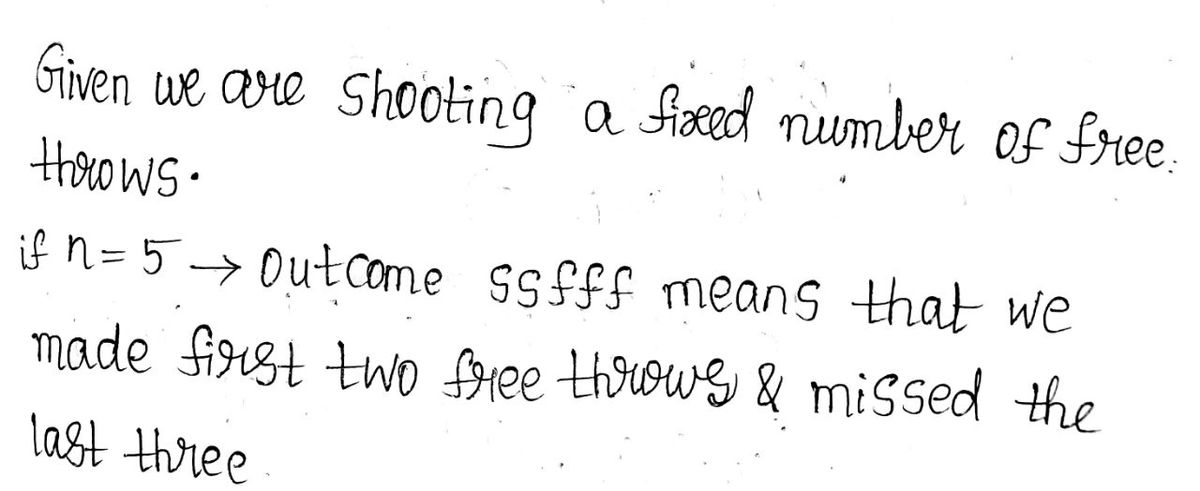3. Suppose we are shooting a fixed number of free throws. If we are shooting n free throws, let's define 2 so that each outcome is a string of n letters where each letter is either an "s" for success or an "f" for failure. Thus, if n = 5, the outcome ssfff means that we made the first two free throws and missed the last three. Define a random variable N, which gives the number of successes. (For example, N(ssfƒƒ) = 2.) (a) If n = 5, how many outcomes are in the event {N = 2}? Give 3 different outcomes in that event. (b) Let 0 < p < 1. If every outcome in the event {N = 2} has probability p²(1 − p)³, compute P{N = 2}. (c) Let every outcome in the event {N = k} have probability pk (1 − p)n-k for k = 0, 1, 2, 3, 4, 5, Compute the p.m.f. of N; i.e., compute pN (k) = PN = k.
3. Suppose we are shooting a fixed number of free throws. If we are shooting n free throws, let's define 2 so that each outcome is a string of n letters where each letter is either an "s" for success or an "f" for failure. Thus, if n = 5, the outcome ssfff means that we made the first two free throws and missed the last three. Define a random variable N, which gives the number of successes. (For example, N(ssfƒƒ) = 2.) (a) If n = 5, how many outcomes are in the event {N = 2}? Give 3 different outcomes in that event. (b) Let 0 < p < 1. If every outcome in the event {N = 2} has probability p²(1 − p)³, compute P{N = 2}. (c) Let every outcome in the event {N = k} have probability pk (1 − p)n-k for k = 0, 1, 2, 3, 4, 5, Compute the p.m.f. of N; i.e., compute pN (k) = PN = k.
College Algebra (MindTap Course List)
12th Edition
ISBN:9781305652231
Author:R. David Gustafson, Jeff Hughes
Publisher:R. David Gustafson, Jeff Hughes
Chapter8: Sequences, Series, And Probability
Section8.7: Probability
Problem 33E: Find the probability of each event. Drawing 5 orange cubes from a bowl containing 5 orange cubes and...
Related questions
Question

Transcribed Image Text:3. Suppose we are shooting a fixed number of free throws. If we are shooting n
free throws, let's define 2 so that each outcome is a string of n letters where
each letter is either an "s" for success or an "f" for failure. Thus, if n = 5, the
outcome ssfff means that we made the first two free throws and missed the
last three.
Define a random variable N, which gives the number of successes. (For
example, N(ssfƒƒ) = 2.)
(a) If n = 5, how many outcomes are in the event {N = 2}? Give 3 different
outcomes in that event.
(b) Let 0 < p < 1. If every outcome in the event {N = 2} has probability
p²(1 − p)³, compute P{N = 2}.
(c) Let every outcome in the event {N = k} have probability pk (1 − p)n-k
for k = 0, 1, 2, 3, 4, 5, Compute the p.m.f. of N; i.e., compute pN (k) =
PN = k.
Expert Solution
Step 1

Step by step
Solved in 4 steps with 4 images

Recommended textbooks for you

College Algebra (MindTap Course List)
Algebra
ISBN:
9781305652231
Author:
R. David Gustafson, Jeff Hughes
Publisher:
Cengage Learning


Algebra & Trigonometry with Analytic Geometry
Algebra
ISBN:
9781133382119
Author:
Swokowski
Publisher:
Cengage

College Algebra (MindTap Course List)
Algebra
ISBN:
9781305652231
Author:
R. David Gustafson, Jeff Hughes
Publisher:
Cengage Learning


Algebra & Trigonometry with Analytic Geometry
Algebra
ISBN:
9781133382119
Author:
Swokowski
Publisher:
Cengage

Algebra and Trigonometry (MindTap Course List)
Algebra
ISBN:
9781305071742
Author:
James Stewart, Lothar Redlin, Saleem Watson
Publisher:
Cengage Learning

College Algebra
Algebra
ISBN:
9781305115545
Author:
James Stewart, Lothar Redlin, Saleem Watson
Publisher:
Cengage Learning

Holt Mcdougal Larson Pre-algebra: Student Edition…
Algebra
ISBN:
9780547587776
Author:
HOLT MCDOUGAL
Publisher:
HOLT MCDOUGAL